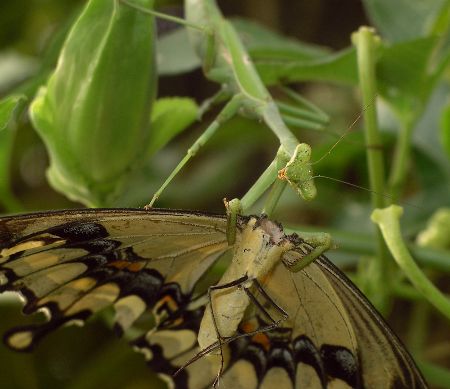by Valerie
October, 2005Carolina Mantid In a slightly grisly Halloween tribute, our featured species this time is the Carolina Mantid (Stagmomantis carolina). Mantids are voracious predators, helping to keep caterpillars and other insect pests that eat garden plants under control. With lightning-quick reactions, mantids are capable of snatching even flying insects using their strong modified front legs. The ambush pose, with these legs folded up, gives the mantid another common name: praying mantis. A further play on words results in the label of preying mantis. There are several different species of mantid, but the most common one in our area is the Carolina. These insects come in a wide range of colors and patterns, from solid light green to brownish green, to mottled gray. They are color phases and the insects do not change to match their background, but may instinctively choose their surroundings to optimize their camouflage. The individual shown above is a female who has just devoured the head of a giant swallowtail butterfly. Male mantids have long wings and can fly short distances. The females, however, have very short wings that are useless for flight, as well as a much wider abdomen. It is well known that the females of some mantid species begin to feast on the male during mating. While it does happen, especially if the female is undernourished, it is not a foregone conclusion. Besides their usual prey, mantids have also been known to catch hummingbirds, a tribute to the strength and determination of these 2.5 inch long insects. |